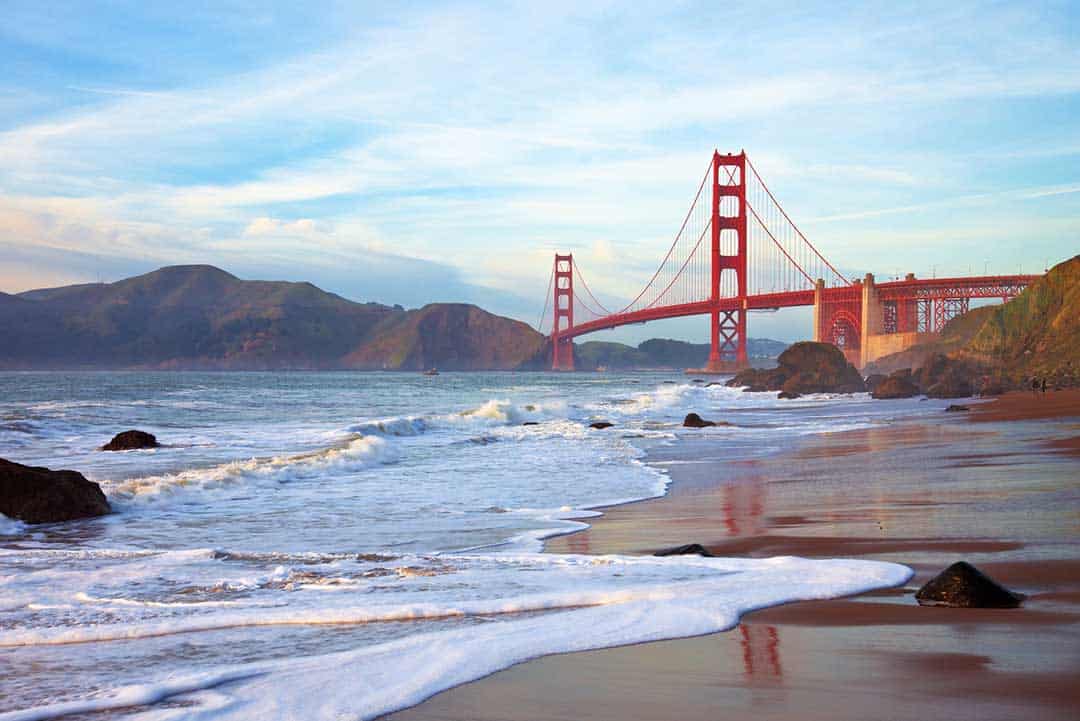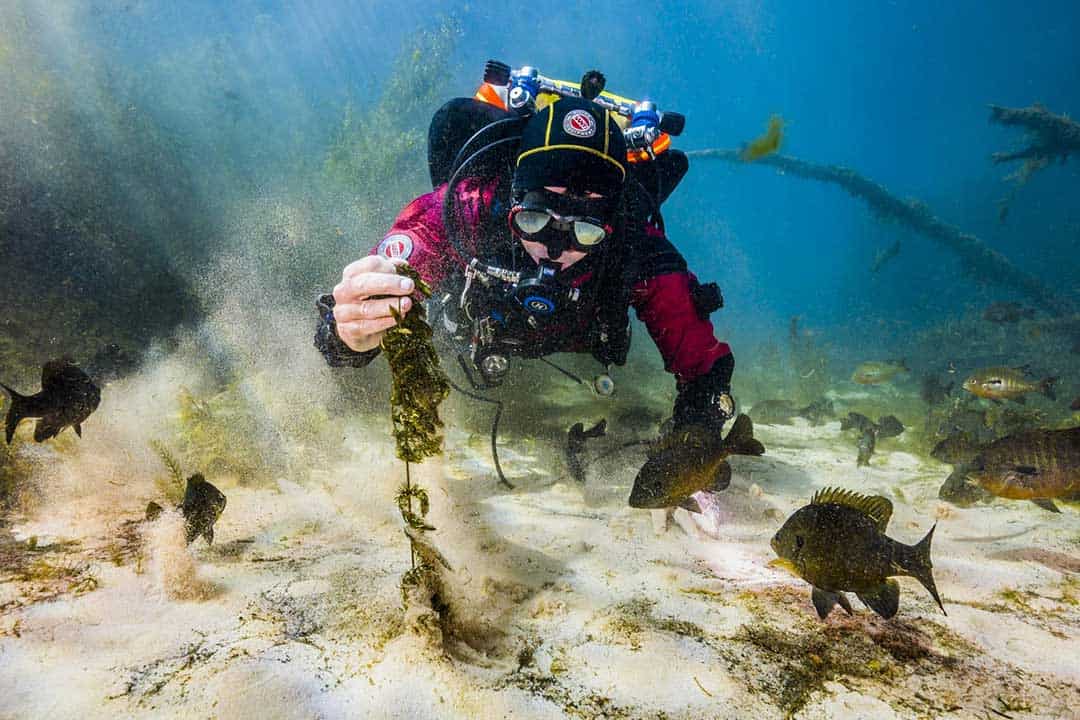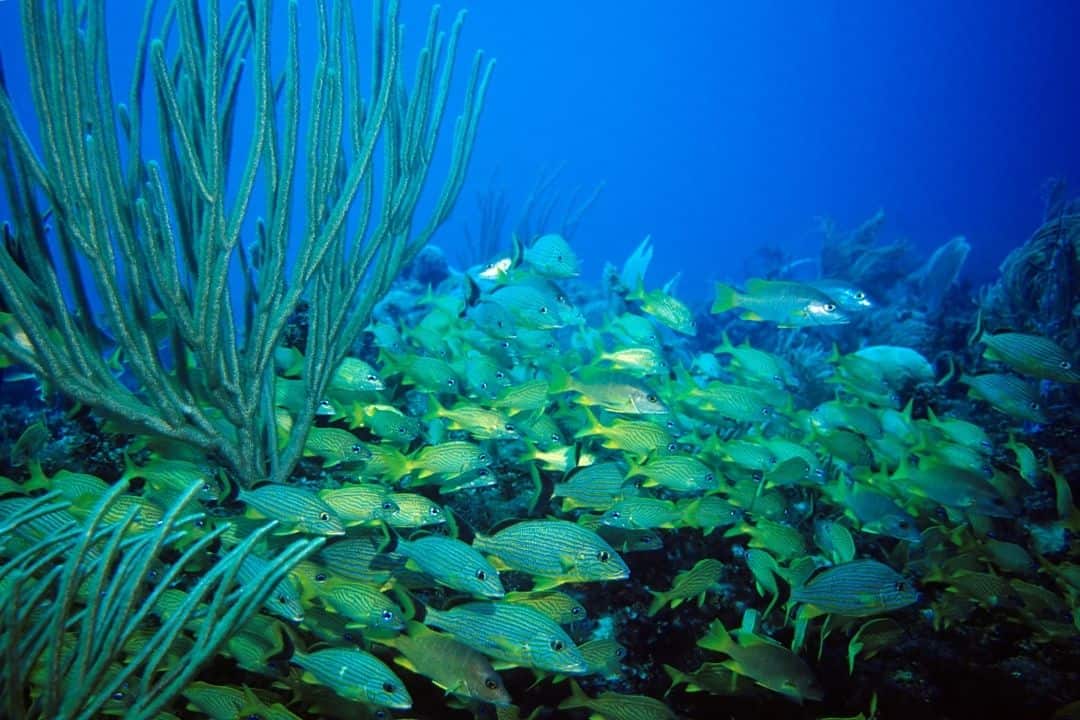Manatees: the gentle giants we’ve come to love and adoringly call ‘sea cows.’
These water-dwelling animals occupy the brackish waters of sunny areas in the southern United States, Central America, and the Caribbean.
If you’ve always wanted to see, swim, or dive with manatees, you’ve come to the right place.
This is the complete guide to everything you need to know and where to go to dive with manatees.
Florida, USA
Manatees seek out warm water in the winter months and are drawn to rivers and springs in Florida.
When ocean temperatures in the Gulf of Mexico drop, manatees migrate inland to Crystal River, Florida (about a 90-minute drive north of Tampa).
They can also be spotted near Homosassa River and Manatee Springs State Park.
Crystal River
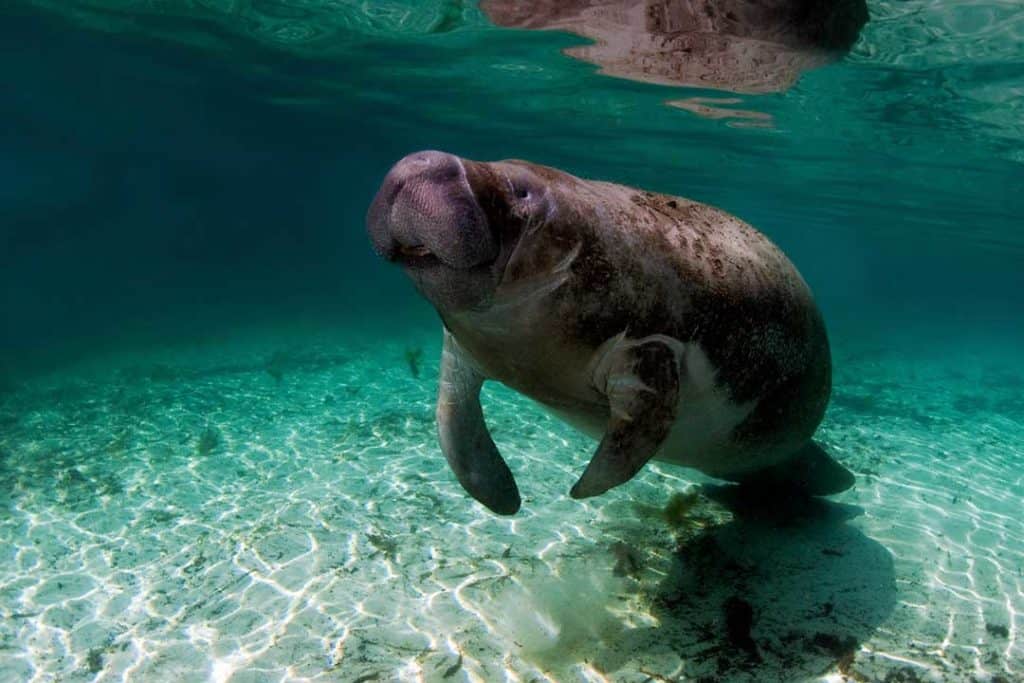
The Crystal River National Wildlife Refuge is world-renowned as the best place for manatee sightings and interactions in the world.
Crystal River itself is a small town, with a quant and colorful few blocks of downtown, but the refuge is where all of the action takes place.
Comprising 46 acres, the refuge is not only home to a resident herd of nearly 100 sea cows, but even more manatees congregate to the Kings Bay area in the winter months to relax in the year-round 72-degree water.
Kings Bay, the headwaters of Crystal River, is the second largest springs group in Florida and the largest natural, warm-water refuge for manatees in the USA.
The 600-acre bay has more than 70 springs scattered throughout it and Three Sisters Springs has the clearest water within the bay.
Although there are numerous dive shops in the area that offer guided swim tours all year long, the best time to swim with these gentle giants is December through March.
This is when they congregate together in the warm waters of Kings Bay.
There are dozens of operators that run tours within the Refuge, all of them carefully licensed and regulated by the U.S Fish & Wildlife Service.
Visitors must adhere to strict guidelines on how to swim, kayak and canoe with manatees.
This means that when you visit, you are not only guaranteed an amazing experience; you can do so safe in the knowledge that you will be treading lightly, that you won’t be stressing the manatees and that others who come after you will also be able to share a similar beautiful experience in the future.
Homosassa River Manatee Tours

Just 10 minutes from Crystal River is Homosassa Springs Wildlife Park and the Rainbow river, across from which are several operators offering florida manatees snorkeling, swimming, and kayak tours in the Homosassa River.
These operators advertise less crowded tours, as compared to their competition in Crystal River.
Manatee Springs State Park

Anyone interested in swimming with manatees can do so in the waters of Manatee Springs State Park, which feeds into the enchanting Suwannee River.
The nearby town also allows you to enjoy a taste of old Florida, as an added bonus.
This park is a very popular drift dive destination for SCUBA divers, who can be found diving there nearly every day of the week.
Alligator Hole, Jamaica

Alligator Hole is the place to view manatees in Jamaica, as well as other types of wildlife. It’s located on the south coast of the island, not far from Treasure Beach.
Alligator Hole is actually not a hole at all, it’s a small river and is home to resident manatees that have been cut off from the sea, as well as hundreds of other incredible species.
There are three manatees that swim upriver each day at 5pm like clockwork, so that they can be fed by local conservationists.
That may not a ton of them, however, there is something to be said for the fact that you are almost guaranteed to see encounter manatees if you go at their scheduled feeding time because they are so adapted to the routine.
There’s plenty of other wildlife viewing to do there at the same time. You can visit Canoe Valley National Nature Preserve (the park which contains Alligator Hole) to visit its manatee habitats or check out the interpretive center.
Belize
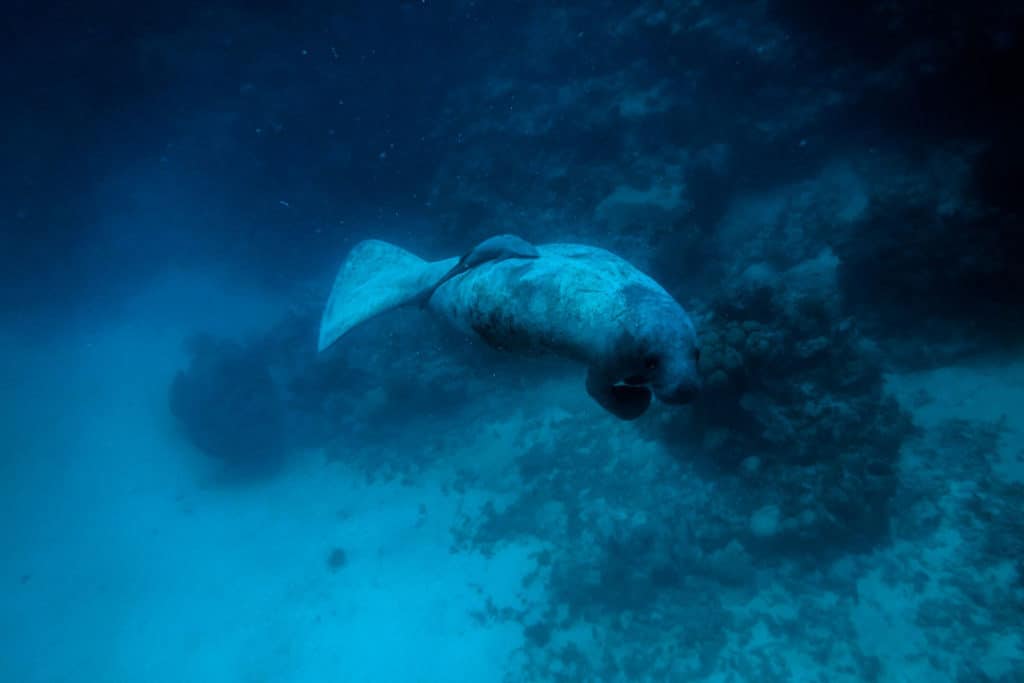
Belize has one of the largest concentrations of manatees in the world, in part because it hosts the largest barrier reef in the Western hemisphere, the Mesoamerican Reef, and also because the country has prioritized protecting these incredible creatures.
These three Belize-based marine reserves offer year-round tours:
- Corozal Bay Wildlife Sanctuary, Northern Lagoon
- Gales Point Manatee Wildlife Sanctuary, Southern Lagoon
- Swallow Caye Wildlife Sanctuary – about 11km/7m from Belize City
Additionally, The Blue Hole, Belize – The Cayes have some of the best snorkeling in the world and you have a great chance of seeing manatees there.
The Dominican Republic
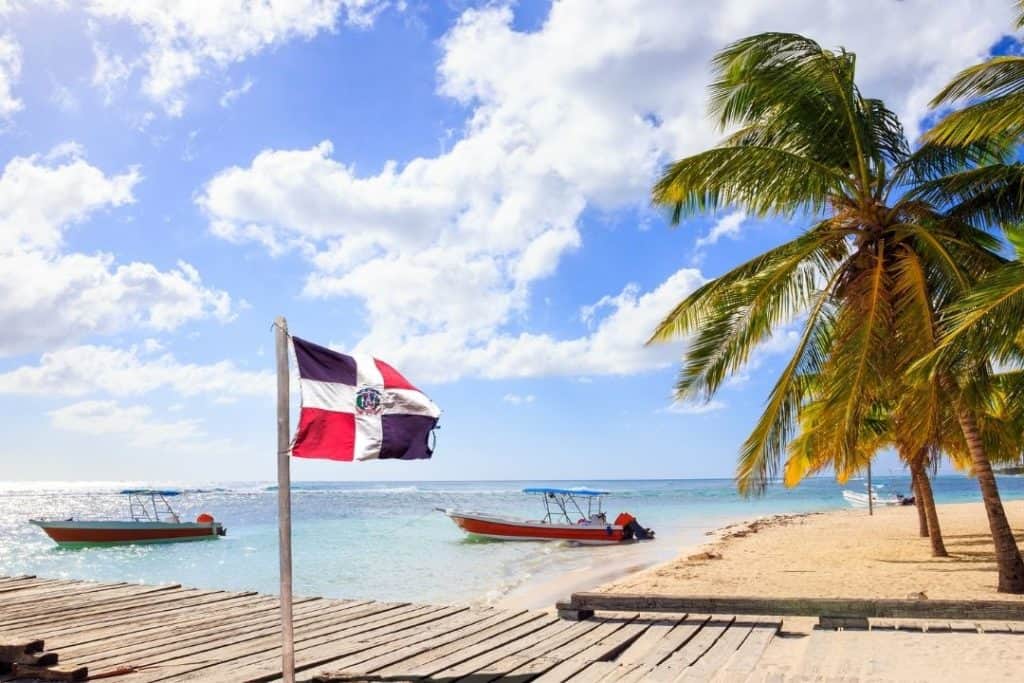
Manatees live in many varied locations around the island, including Jaragua National Park in the south and on the west side of the island.
There is also the option to take a hike to a lagoon in the Estero Hondo Marine Mammal Sanctuary where you may be greeted by a friendly manatee.
Playa del Carmen, Mexico

In Mexico, there are a ton of places to meet manatees.
However, Xel-Há Park near Playa del Carmen offers a unique opportunity to engage with them.
This unique park has a rescue and conservation program dedicated to manatee encounters. They also run an educational tour that includes feeding them.
It’s one of the few spots that offers an educational opportunity, beyond just asking your tour guide questions, to learn more about manatees and raises awareness of their vulnerable status.
Tortuguero National Park, Costa Rica

Tortuguero National Park is a spectacular spot to see manatees. Costa Rica is well-known for its’ wildlife, and this national park is no different.
This huge park is a famous turtle nesting site and is home to sixty different species of mammal, including West Indian manatees.
There are several boat tours and private tours which can give you up-close access to manatees. It’s important to note that there aren’t any in-water opportunities here, however.
Iquitos, Peru

Iquitos, Peru is home to the Centro de Rescate Amazónico (CREA), where orphan baby manatees are cared for until they can survive on their own in the wild.
Visitors are welcome here and are an important source of funding for the center, but they don’t offer diving or snorkeling opportunities here to help protect the baby manatees.
Diving & Swimming with Manatees
Which months are best for seeing manatees?
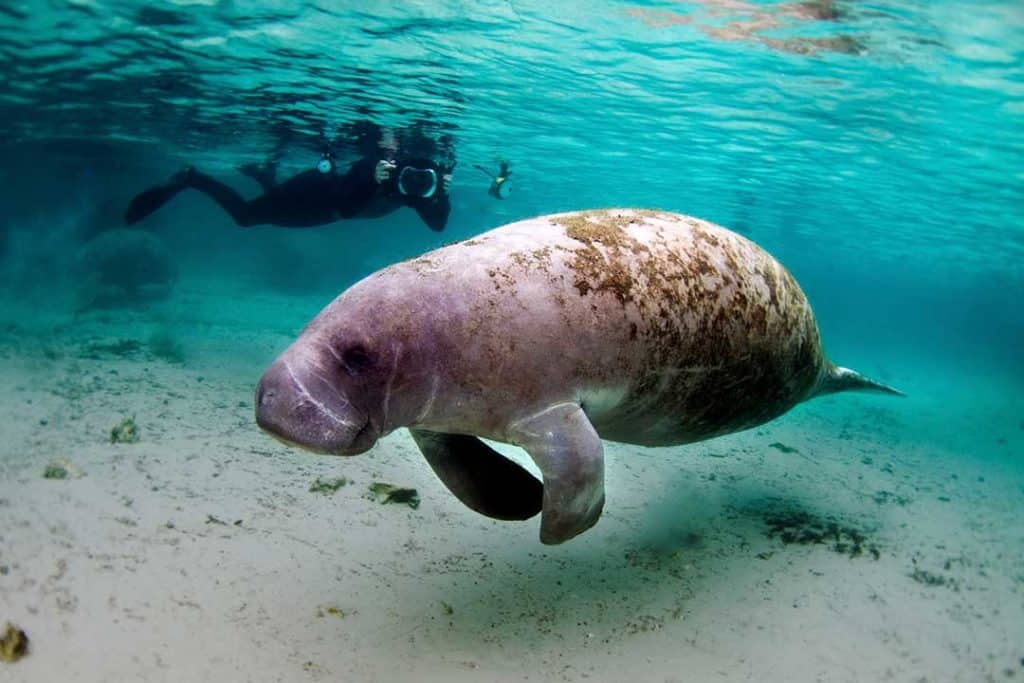
Peak season for observing manatees is November through April, and the local manatee population is largest between December and February.
You can spot manatees year-round in some areas, but the population can be much smaller during the summer months because of migration.
What time of day is best for swimming with manatees?
When planning your trip, consider visiting early morning and during the middle of the week. Tourist destinations, as a general rule, are less crowded on weekdays.
Also, manatees tend to be most active and playful in the mornings.
Can you touch manatees?
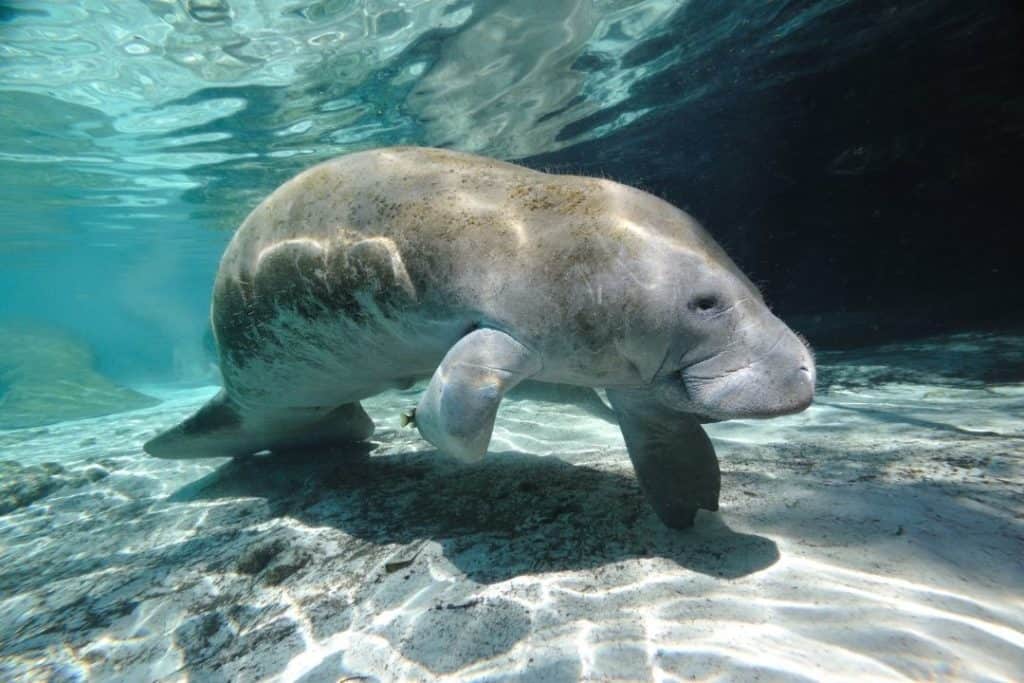
Since manatees are an endangered species, they are protected by law.
If you head out on a tour, your guide will share all the do’s and don’ts for that area, especially if it’s a protected area or national park of sorts.
In some areas, it is legal to touch them gently with one hand, however, this isn’t permitted everywhere, and local guidelines should be adhered to.
Why Are Manatees Endangered?
Manatees have no natural predators, besides crocodiles, which is rare, but they are threatened by low temperatures and several diseases.
However, the biggest threat to manatee populations is human activity: collisions with boats, habitat loss and degradation, fishing gear entanglement, human harassment, exposure to red tide and other harmful algal blooms, and climate change, etc.
The greatest long-term threat is the loss of warm water habitat. Because of these strains, the population of manatees globally has been reduced tremendously.
As new developments are built along waterways, natural nesting areas are destroyed. Sewage, manure, and fertilizer run-off enters the water and causes algal blooms.
Some of this alga is toxic and can kill manatees if they eat it.
Because manatees feed on sea grass, and sea grass needs sunlight and shallow water to grow, manatees spend most of their time in shallow water.
This often leaves them with little room to dive away from oncoming boats, which can lead to deadly collisions.
As a result, manatees are classified as endangered by many countries, although the United States have recently downgraded their status to ‘threatened’.
As of 2016, there were about 6,000 West Indian manatees in Florida and about 13,000 worldwide.
Manatee species
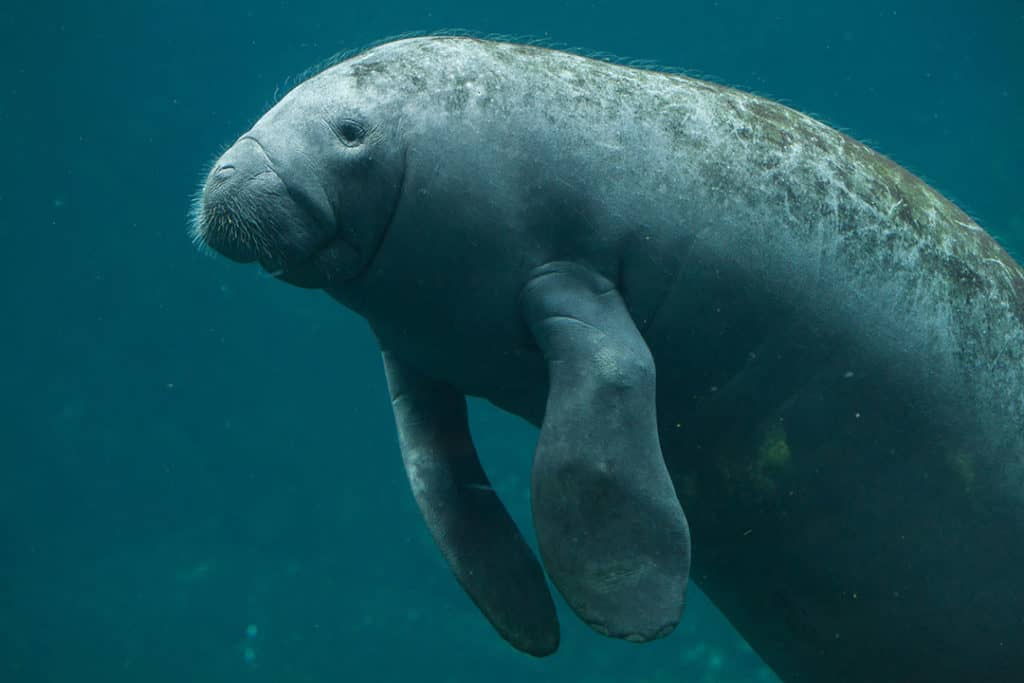
There are three manatee species worldwide:
- The Amazonian manatee – Trichechus inunguis
- The West African manatee – Trichechus senegalensis
- The West Indian manatee – Trichechus manatus
Scientists also recognize 2 subspecies of West Indian manatee: T.m. latirostris, the Florida manatee, and T.m. manatus, the Antillean manatee.
All three are listed as vulnerable to extinction.
What can be done to help protect endangered species like the manatees? The first step is always to try to inform the public through education.
Educational campaigns teach boaters to look for patterns caused by a manatee’s tail on the surface of the water, so they’ll know if a manatee is nearby and to proceed cautiously through shallow waterways.
In some areas, local governments have adopted slow-speed zones in known manatee habitat areas.
In the state of Florida, a free Manatee Alert mobile app is available.
Best Practice
Manatees are an essential component of our planet’s ecosystem. They are grazers, which mean they help to recycle energy through the food chain.
Therefore, it’s essential that you consider embarking on an eco-friendly manatee tour to help bring awareness to the necessity of these gentle creatures.
Whenever possible, book a visit with organizations that recognize the importance of respecting the animal’s safety, and support manatee research, protection, and public education efforts.
Manatees are curious, very playful, and will surprise you by interacting with humans.
But you should always stay quiet, give them space and respect, and let them initiate contact.

Although you can dive with manatees in some places, the best experience for both yourself and the manatees in usually snorkeling or swimming, as the bubbles from SCUBA diving may scare them away.
Manatees are sensitive to movement and sound. These mammals also tend to reside in shallow areas, so they can easily be viewed from the surface or by free diving down a little bit.
The phrase that will likely be repeatedly said during your manatee excursion briefing is: “passive interaction.” Quietly observing is key.
If a manatee is comfortable and not intimidated by you, they may come up close and initiate interaction with you on their own.
This is a very exciting experience, if it happens, but shouldn’t be forced on the animals. Most tour operators will explain all the rules and inform you of how best to act before they take you to swim with the manatees.
Also, be mindful of your buoyancy and fin kicks as your manatee encounter will likely take place in a shallow area with fragile habitat.
How You Can Help Protect Manatees
- Help keep manatee habitat clean- One of the best ways to help manatees and other wildlife survive is to participate with shoreline, beach, park or roadside cleanup events in your area. If you are enjoying a day in the outdoors you are encouraged to pick up litter or discarded fishing line and dispose of it properly.
- Avoid traveling in seagrass or other shallow areas where manatees may be feeding or resting. Look out for manatees and give them space.
- Check with local environmental organizations to see if you can volunteer or conduct a community service project that would benefit manatee conservation.
- Recycle your monofilament fishing line in designated bins near docks, ramps or in tackle shops. Get your civic group to adopt or monitor a recycling bin in your area.
Experiencing the incredible company of manatees or “sea-cows” is an opportunity that shouldn’t be missed.
Keeping manatee’s safety in mind, there are many beautiful places in the world to view, swim, and dive with manatees and take in incredible sights.
An essential element to appreciation of our natural world, is having meaningful interactions with it.
I hope you create a beautiful life-long memory with a manatee!
